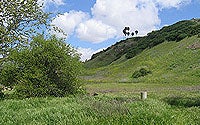Marian Bear Memorial Park History

Marian Bear Memorial Park - Rededicated by the City Council of the City of San Diego on behalf of this City who are indebted to Marian Bear for her energetic and unselfish efforts as a planner, naturalist and conservationist and her lasting contributions toward the preservation of open space for future generations. July 31, 1979.
History of the Park
Native Americans have inhabited the area of San Diego County for 10,000 years. Evidence of their presence still remains in San Clemente Canyon. They camped around waterholes and streams, hunted game, and gathered wild foods from the area. While harvesting the abundant resources, Native Americans were aware of the balance between people and the environment.
In the late 19th century, this area was named Clemente Canyon for a Native American rancher. During the 1970s nature's balance was threatened by plans to place state Route 52 along the canyon floor.
Marian Bear, an active community leader and environmentalist, worked tirelessly to preserve the canyons in their natural state. She was the driving force behind realigning the highway from the canyon floor to the north hillsides. In the 1980s another community campaign resulted in an additional 72 acres in the southeast section for the present total of 467 acres.
San Clemente Canyon
Over 40 million years ago an ocean covered San Clemente Canyon. Fossilized mollusks, such as snails and clams from that period are still found in the canyon walls. Horizontal lines of round rocks at many levels, separated by clay and sand, represent the various levels of the ocean washing sand away and leaving rocks at surf level. Wind and water erosion have also contributed to the depth of San Clemente Canyon. The creek now meanders down the floor of the canyon, which it continues to deepen and widen.
The main canyon and its tributaries continue to support a population of resident wildlife, including raccoons, skunks, rabbits, amphibians, reptiles and birds, and serve as a pathway for coyote, fox and other mammals. Along the length of the canyon are oak, sycamore and willow trees with their ever attendant undergrowth of native and other plant species. The native plant communities are closely related to the natural climatic zone in which they are found and the underlying soil in which they must grow.
The canyon has an intermingling of native plant communities, some of whose range is restricted to Southern California and northern Baja California. There is a riparian woodland along the creek beds and side canyons where water flows. The hillsides contain coastal sage scrub and chaparral, two plant communities characterized by their adaptation to survive prolonged drought and periodic brush fires.

